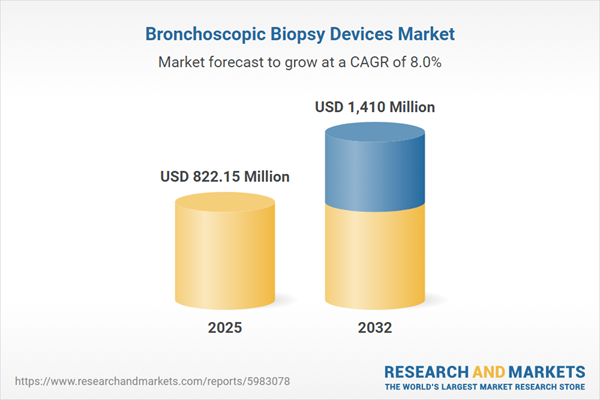Speak directly to the analyst to clarify any post sales queries you may have.
The bronchoscopic biopsy devices market is evolving rapidly, with advancements in diagnostic accuracy and workflow integration becoming central to healthcare delivery. Adaptation to new technologies and procedural demands is crucial for executives seeking to lead in clinical innovation and operational resilience.
Market Snapshot: Bronchoscopic Biopsy Devices Market
The global bronchoscopic biopsy devices market is projected to grow from USD 764.65 million in 2024 to USD 822.15 million in 2025, reaching USD 1.41 billion by 2032, with a CAGR of 7.97%. This trajectory is fueled by greater awareness of respiratory conditions and a shift toward minimally invasive diagnostics. Leading companies are prioritizing workflow digitization and clinical differentiation to meet heightened expectations in care delivery and efficiency.
Scope & Segmentation
- Technology: Convex Probe EBUS, Radial EBUS, and Electromagnetic Navigation systems offer enhanced imaging capabilities to support precision targeting of pulmonary lesions in both routine and complex bronchoscopic procedures.
- Product Type: Double Channel Devices provide increased multitasking during interventions, Single Channel Devices are tailored for procedural speed, and Ultrathin Devices support access in anatomically challenging cases, making them adaptable to varied care environments.
- Application: Devices serve central lesion diagnosis, peripheral lesion detection, and mediastinal staging, facilitating a range of uses from primary pulmonary evaluation to specialized cancer assessments.
- End User: Hospitals utilize these devices for comprehensive respiratory diagnostics; Ambulatory Surgical Centers prioritize procedural efficiency; Specialized Cancer Centers focus on integration within oncology treatment pathways.
- Procedure Type: Devices support both diagnostic and therapeutic bronchoscopic procedures, streamlining pathways from sample collection to potential intervention within the same care episode.
- Regions: Adoption spans the Americas, Europe, Middle East & Africa, and Asia-Pacific. The United States and Germany regularly serve as benchmarks for innovation and regulatory leadership, while varied infrastructure maturity shapes market dynamics across geographies. Regulatory frameworks and reimbursement environments play a defining role in technology uptake.
- Companies Profiled: Key stakeholders include Olympus Corporation, Boston Scientific Corporation, Medtronic plc, FUJIFILM Holdings Corporation, HOYA Corporation, KARL STORZ SE & Co. KG, Cook Medical LLC, Ambu A/S, Richard Wolf GmbH, and CONMED Corporation, each contributing to advancements in bronchoscopic technology and global expansion efforts.
Key Takeaways for Senior Leaders
- Digital imaging and advanced artificial intelligence are raising quality and reliability benchmarks for clinical workflows, enabling scalable improvements in diagnosis.
- User-centered interfaces drive faster clinical adoption and support effective team coordination, supporting operational continuity even with varied staffing.
- Collaboration among manufacturers and clinical experts propels rapid evolution of industry protocols, translating to solutions that match current practitioner needs and speed market adoption.
- Flexible, value-based procurement strategies—incorporating risk-sharing or adaptive financing—help healthcare organizations align capital outlays with changing reimbursement pressures.
- Deploying region-specific strategies ensures seamless device integration within local health systems, fostering compliance and ease of adoption in diverse markets.
- Attention to life cycle management across devices enables providers to optimize resource usage and control ongoing operational costs.
Assessing Tariff Impact on Value Chains
US tariff policy adjustments have increased operational costs and created greater supply chain complexity for bronchoscopic biopsy device manufacturers. Companies are responding with local assembly initiatives, expanded supplier networks, and improved inventory systems to strengthen resilience. Healthcare providers are leveraging cooperative purchasing arrangements and reviewing procurement approaches to maintain consistent access to critical diagnostic equipment. Near-shoring and diversified sourcing strategies further support continuity and adaptability to regulatory changes.
Methodology & Data Sources
This analysis is informed by direct expert interviews, evaluation of company financial reports, regulatory reviews, and assessment of published clinical literature. Industry panel validation ensures the reported insights are accurate and tailored for decision-makers active in the bronchoscopic biopsy devices market.
Why This Report Matters
- Delivers actionable insights for executive planning across risk management, investment, and strategic operations within bronchoscopic device procurement.
- Enables leadership to address regulatory, clinical, and logistical complexities unique to advanced pulmonary diagnostic technologies.
- Supports ongoing competitive benchmarking and strategic adjustment needed to align with shifting healthcare delivery objectives.
Conclusion
Strategic leadership in the bronchoscopic biopsy devices field depends on ongoing technology investments, close clinical partnerships, and adaptive supply strategies. This report provides the executive intelligence necessary for navigating market shifts in this specialized segment.
Additional Product Information:
- Purchase of this report includes 1 year online access with quarterly updates.
- This report can be updated on request. Please contact our Customer Experience team using the Ask a Question widget on our website.
Table of Contents
3. Executive Summary
4. Market Overview
7. Cumulative Impact of Artificial Intelligence 2025
Companies Mentioned
The companies profiled in this Bronchoscopic Biopsy Devices market report include:- Olympus Corporation
- Boston Scientific Corporation
- Medtronic plc
- FUJIFILM Holdings Corporation
- HOYA Corporation
- KARL STORZ SE & Co. KG
- Cook Medical LLC
- Ambu A/S
- Richard Wolf GmbH
- CONMED Corporation
Table Information
| Report Attribute | Details |
|---|---|
| No. of Pages | 183 |
| Published | October 2025 |
| Forecast Period | 2025 - 2032 |
| Estimated Market Value ( USD | $ 822.15 Million |
| Forecasted Market Value ( USD | $ 1410 Million |
| Compound Annual Growth Rate | 7.9% |
| Regions Covered | Global |
| No. of Companies Mentioned | 11 |









